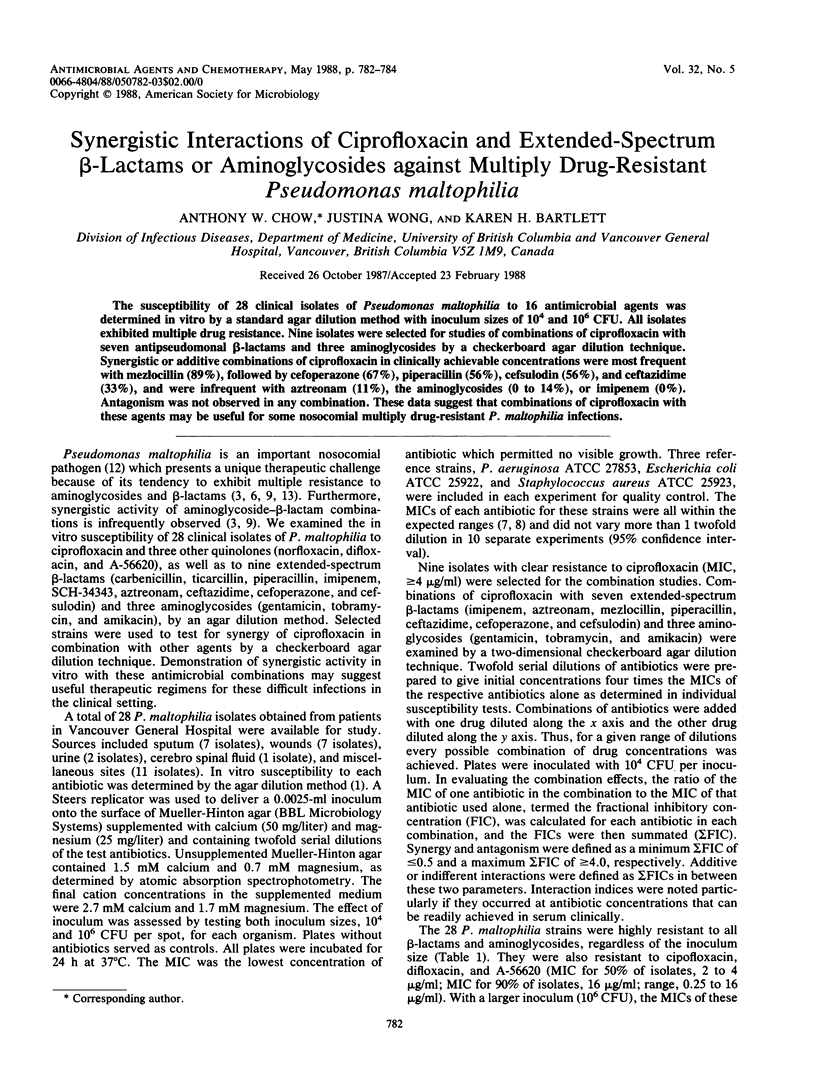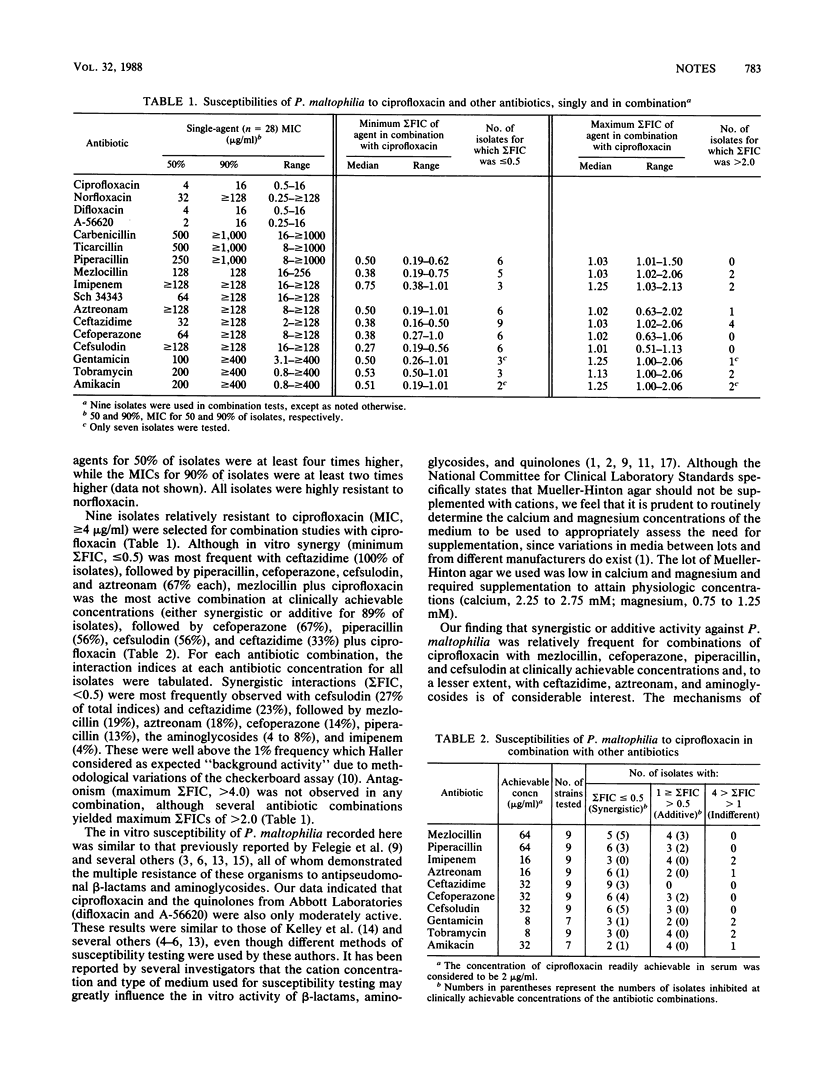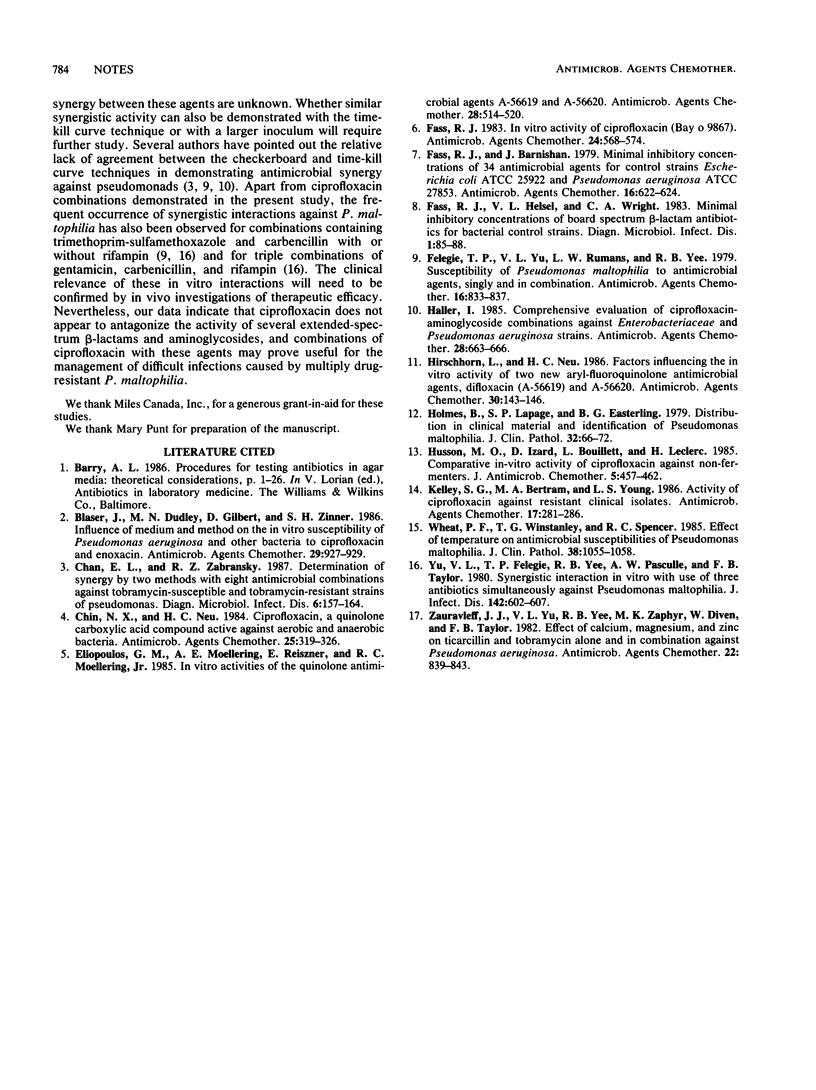Abstract
The susceptibility of 28 clinical isolates of Pseudomonas maltophilia to 16 antimicrobial agents was determined in vitro by a standard agar dilution method with inoculum sizes of 10(4) and 10(6) CFU. All isolates exhibited multiple drug resistance. Nine isolates were selected for studies of combinations of ciprofloxacin with seven antipseudomonal beta-lactams and three aminoglycosides by a checkerboard agar dilution technique. Synergistic or additive combinations of ciprofloxacin in clinically achievable concentrations were most frequent with mezlocillin (89%), followed by cefoperazone (67%), piperacillin (56%), cefsulodin (56%), and ceftazidime (33%), and were infrequent with aztreonam (11%), the aminoglycosides (0 to 14%), or imipenem (0%). Antagonism was not observed in any combination. These data suggest that combinations of ciprofloxacin with these agents may be useful for some nosocomial multiply drug-resistant P. maltophilia infections.
Full text
PDF


Selected References
These references are in PubMed. This may not be the complete list of references from this article.
- Blaser J., Dudley M. N., Gilbert D., Zinner S. H. Influence of medium and method on the in vitro susceptibility of Pseudomonas aeruginosa and other bacteria to ciprofloxacin and enoxacin. Antimicrob Agents Chemother. 1986 May;29(5):927–929. doi: 10.1128/aac.29.5.927. [DOI] [PMC free article] [PubMed] [Google Scholar]
- Chan E. L., Zabransky R. J. Determination of synergy by two methods with eight antimicrobial combinations against tobramycin-susceptible and tobramycin-resistant strains of Pseudomonas. Diagn Microbiol Infect Dis. 1987 Feb;6(2):157–164. doi: 10.1016/0732-8893(87)90101-5. [DOI] [PubMed] [Google Scholar]
- Chin N. X., Neu H. C. Ciprofloxacin, a quinolone carboxylic acid compound active against aerobic and anaerobic bacteria. Antimicrob Agents Chemother. 1984 Mar;25(3):319–326. doi: 10.1128/aac.25.3.319. [DOI] [PMC free article] [PubMed] [Google Scholar]
- Eliopoulos G. M., Moellering A. E., Reiszner E., Moellering R. C., Jr In vitro activities of the quinolone antimicrobial agents A-56619 and A-56620. Antimicrob Agents Chemother. 1985 Oct;28(4):514–520. doi: 10.1128/aac.28.4.514. [DOI] [PMC free article] [PubMed] [Google Scholar]
- Fass R. J., Barnishan J. Minimal inhibitory concentrations of 34 antimicrobial agents for control strains Escherichia coli ATCC 25922 and Pseudomonas aeruginosa ATCC 27853. Antimicrob Agents Chemother. 1979 Nov;16(5):622–624. doi: 10.1128/aac.16.5.622. [DOI] [PMC free article] [PubMed] [Google Scholar]
- Fass R. J., Helsel V. L., Wright C. A. Minimal inhibitory concentrations of broad spectrum beta-lactam antibiotics for bacterial control strains. Diagn Microbiol Infect Dis. 1983 Mar;1(1):85–88. doi: 10.1016/0732-8893(83)90036-6. [DOI] [PubMed] [Google Scholar]
- Fass R. J. In vitro activity of ciprofloxacin (Bay o 9867). Antimicrob Agents Chemother. 1983 Oct;24(4):568–574. doi: 10.1128/aac.24.4.568. [DOI] [PMC free article] [PubMed] [Google Scholar]
- Felegie T. P., Yu V. L., Rumans L. W., Yee R. B. Susceptibility of Pseudomonas maltophilia to antimicrobial agents, singly and in combination. Antimicrob Agents Chemother. 1979 Dec;16(6):833–837. doi: 10.1128/aac.16.6.833. [DOI] [PMC free article] [PubMed] [Google Scholar]
- Haller I. Comprehensive evaluation of ciprofloxacin-aminoglycoside combinations against Enterobacteriaceae and Pseudomonas aeruginosa strains. Antimicrob Agents Chemother. 1985 Nov;28(5):663–666. doi: 10.1128/aac.28.5.663. [DOI] [PMC free article] [PubMed] [Google Scholar]
- Hirschhorn L., Neu H. C. Factors influencing the in vitro activity of two new aryl-fluoroquinolone antimicrobial agents, difloxacin (A-56619) and A-56620. Antimicrob Agents Chemother. 1986 Jul;30(1):143–146. doi: 10.1128/aac.30.1.143. [DOI] [PMC free article] [PubMed] [Google Scholar]
- Holmes B., Lapage S. P., Easterling B. G. Distribution in clinical material and identification of Pseudomonas maltophilia. J Clin Pathol. 1979 Jan;32(1):66–72. doi: 10.1136/jcp.32.1.66. [DOI] [PMC free article] [PubMed] [Google Scholar]
- Husson M. O., Izard D., Bouillet L., Leclerc H. Comparative in-vitro activity of ciprofloxacin against non-fermenters. J Antimicrob Chemother. 1985 Apr;15(4):457–462. doi: 10.1093/jac/15.4.457. [DOI] [PubMed] [Google Scholar]
- Kelley S. G., Bertram M. A., Young L. S. Activity of ciprofloxacin against resistant clinical isolates. J Antimicrob Chemother. 1986 Mar;17(3):281–286. doi: 10.1093/jac/17.3.281. [DOI] [PubMed] [Google Scholar]
- Wheat P. F., Winstanley T. G., Spencer R. C. Effect of temperature on antimicrobial susceptibilities of Pseudomonas maltophilia. J Clin Pathol. 1985 Sep;38(9):1055–1058. doi: 10.1136/jcp.38.9.1055. [DOI] [PMC free article] [PubMed] [Google Scholar]
- Yu V. L., Felegie T. P., Yee R. B., Pasculle A. W., Taylor F. H. Synergistic interaction in vitro with use of three antibiotics simultaneously against Pseudomonas maltophilia. J Infect Dis. 1980 Oct;142(4):602–607. doi: 10.1093/infdis/142.4.602. [DOI] [PubMed] [Google Scholar]
- Zuravleff J. J., Yu V. L., Yee R. B., Zaphyr M. K., Diven W., Taylor F. B. Effect of calcium, magnesium, and zinc on ticarcillin and tobramycin alone and in combination against Pseudomonas aeruginosa. Antimicrob Agents Chemother. 1982 Nov;22(5):839–843. doi: 10.1128/aac.22.5.839. [DOI] [PMC free article] [PubMed] [Google Scholar]


